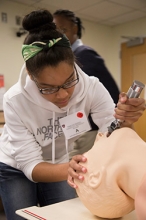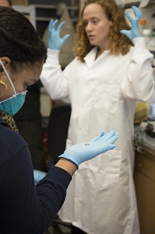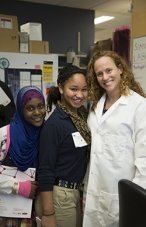Middle School Programs
‘Explorations’ Brings Science to Life for Boston Teens
 After a visit to BIDMC, a group of Boston middle school students learned the surprising truth that things like video games and mouse brains can actually be useful!
After a visit to BIDMC, a group of Boston middle school students learned the surprising truth that things like video games and mouse brains can actually be useful!
 Participating in Harvard Medical School (HMS)’s 14th annual “Explorations” program, BIDMC staff helped open the minds of 37 local middle schoolers who visited BIDMC on Oct. 22 for a hands-on exercise in the “real world” applications of classroom science.
Participating in Harvard Medical School (HMS)’s 14th annual “Explorations” program, BIDMC staff helped open the minds of 37 local middle schoolers who visited BIDMC on Oct. 22 for a hands-on exercise in the “real world” applications of classroom science.
“Explorations” is co-sponsored by Harvard’s Office for Diversity Inclusion, Minority Faculty Development Program/Educational Outreach Programs and the Biomedical Science Careers Program. The yearly event provides middle school students with math and science experiences outside the classroom and creates opportunities for meeting role models and discovering career options.
This year, BIDMC hosted students from the Davis Leadership Academy Charter Public School, Dorchester; Franklin D. Roosevelt School, Hyde Park; Higginson-Lewis School, Roxbury; and Warren-Prescott School, Charlestown.
“Since its inception, BIDMC has exposed approximately 500 students to the excitement of working in the field of science,” said Jane Matlaw, Director, Community Relations. “It is really because of our dedicated employee volunteers that this program is so successful. They make the science come alive by sharing what they do and why they do it.”
After a morning of presentations at HMS, more than 400 participating students were divided among several Longwood and greater Boston area science and medical institutions. At BIDMC, students split into smaller groups and visited one of eight destinations, including the Simulation and Skills Center, Rehabilitation Services, Blood Bank, Neurology, Radiation Oncology, Endocrinology Research, Cardiology, and Medicine.
 Joanne Clark, PhD, Neurology, led a group of five students to the Center for Life Sciences, where they visited a neurology research lab.
Joanne Clark, PhD, Neurology, led a group of five students to the Center for Life Sciences, where they visited a neurology research lab.
“In research, the challenge is to take a big question and make it smaller and smaller,” she said. Clark showed the students a preserved human brain, and compared it to the mouse brains she and her team use for Parkinson’s disease research.
“I’ve never seen a real brain before,” said Janice Andrade, an eighth-grader at the Higginson-Lewis School. After donning a pair of gloves, she even got to hold a mouse brain. “I really enjoyed it!” she said.
In the Simulation and Skills Center, Darren Tavernelli, RN, RRT, and Michael McBride, RN, gave hands-on training in performing an intubation using training mannequins. After some practice, students teamed up in pairs and raced to “save a life” by being the fastest team to complete the procedure successfully.
Denroy Athill, an aspiring scientist enrolled at Davis Leadership Academy, was impressed by the training tools. “The instructors could do a lot with these mannequins – they could make them bleed, have a heart attack – and we learned how they use these tools to help train doctors and nurses.”
Later, the students used a video simulator to learn what it takes to remove a gallbladder. They took turns at the helm of hand-held controls while a video screen replicated their hand movements as they sliced the gall bladder free from its surrounding structures. It may have looked like a video game, but this valuable training system was about more than just high scores.
In addition to Clark, Tavernelli and McBride, other BIDMC staff who volunteered to lead student tours included: Mark Andermann, PhD, Medicine; Stacy Potvin, Physical Therapist Assistant, Rehabilitation Services; Monique Mohamed, Senior Technologist, Pathology/Blood Bank; Joe Mancias, MD, PhD, Radiation Oncology; Maria Kontaridis, PhD, Cardiology; and Mary-Elizabeth Patti, MD, Endocrinology.
BIDMC TODAY - Published on 10/29/2014
Photos courtesy of Beth Israel Deaconess Medical Center, Boston, MA
